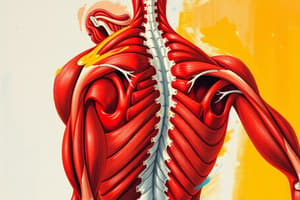Podcast
Questions and Answers
What is the primary muscle involved in trunk flexion?
What is the primary muscle involved in trunk flexion?
- Transversus abdominis
- Internal obliques
- External obliques
- Rectus abdominis (correct)
Which of the following muscles acts as accessory muscles during trunk flexion?
Which of the following muscles acts as accessory muscles during trunk flexion?
- External obliques (correct)
- Pectoralis major
- Gluteus maximus
- Latissimus dorsi
What is a factor that limits the range of motion in trunk flexion?
What is a factor that limits the range of motion in trunk flexion?
- Weakness of spinal extensor muscles
- Increased flexibility of abdominal muscles
- Tension of the posterior longitudinal ligament (correct)
- Movement of the scapulae
Where does the range of motion of trunk flexion primarily take place?
Where does the range of motion of trunk flexion primarily take place?
What is the nerve supply for the rectus abdominis muscle?
What is the nerve supply for the rectus abdominis muscle?
Flashcards
Primary Trunk Flexor
Primary Trunk Flexor
Rectus abdominis is the main muscle responsible for trunk flexion.
Trunk Flexion Range of Motion
Trunk Flexion Range of Motion
The range of movement (flexion) of the trunk, from a supine position (lying on the back) to a sitting position.
Accessory Trunk Flexors
Accessory Trunk Flexors
Internal and external obliques assist in trunk flexion, working with rectus abdominis.
Factors Limiting Trunk Flexion
Factors Limiting Trunk Flexion
Signup and view all the flashcards
Rectus Abdominis Origin
Rectus Abdominis Origin
Signup and view all the flashcards
Study Notes
Trunk Flexion
- Objectives: Students will be able to identify the primary muscles involved in trunk flexion and the range of motion for trunk flexion.
Primary Muscles
- Rectus abdominis: A primary muscle for trunk flexion.
Accessory Muscles
- Internal obliques
- External obliques
Range of Motion & Fixation
- Back lying position: Flexion of thorax on pelvis until scapulae are lifted from the table, primarily in the thoracic spine. The motion continues to sitting position due to hip flexors' reverse action with abdominal muscles acting as stabilizers.
Factors Limiting Motion
- Tightness in posterior longitudinal ligaments, ligamentum flavum, interspinal and supraspinal ligaments.
- Tension in spinal extensor muscles.
- Compressing the intervertebral fibrocartilages.
- Contact between lower ribs and abdomen.
Anatomy of Rectus Abdominis
- Origin: Crest of pubis, ligaments covering front of symphysis pubis.
- Insertion: Three portions into cartilages of fifth, sixth, and seventh ribs.
- Nerve supply: Lower intercostal nerves.
Studying That Suits You
Use AI to generate personalized quizzes and flashcards to suit your learning preferences.



